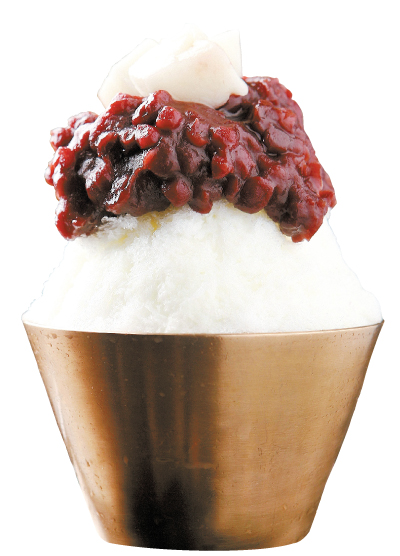[Iconic Food] Bingsu: Korea’s most dynamic dessert

Although the dessert is not only enjoyed in Korea, the name bingsu has gone global just like other modern-day Korean foods like chimaek, a combination of fried chicken and beer. The modern-day bingsu is thought to have come from Japan during Japanese colonial rule (1910-1945), and then became more popular when restaurants and cafes could more easily make and store ice. The most basic ingredient for bingsu is ice flakes. Boiled and cooled red beans are also considered to be a part of what makes a classic bingsu, which is why Koreans used to call the dessert patbingsu (pat meaning red beans). But as some people did not enjoy red beans, the term bingsu became more popular. i
Until in the late 1990s, bingsu was usually made with clear ice, red beans and fruit jelly with drops of milk. The amount of milk or condensed milk determined how silky the bingsu was and many people bought small ice grinders to make a quick bowl of bingsu at home as well. Some added cereal for more crispy texture or grain powder called misutgaru for a creamier taste. Some frozen strawberries were added but not often.
The country was then hit hard by Iceberry in 1999, a franchise bingsu shop where large, sharable bingsu covered in all kinds of frozen fruits were served. The bowl was large enough to share with more than four people. This was the beginning of when people started to think that bingsu could be a dessert for any season. Many different neighborhoods started to welcome the particular dessert spot, and customers of all ages came in groups to share a big bowl. Shops with similar fruit bingsu concepts started to spring up in the early 2000s, and those who did not enjoy red beans had much to rejoice.

From left: Hotel Shilla Seoul’s Apple Mango Bingsu, The Westin Chosun Seoul’s Watermelon Bingsu, Sulbing’s Injeolmi Bingsu
At around the same time, the love for creamier ice flakes started to rise and some shops started to serve milk ice flakes, which has continued to today.
Mealtop, which has served bingsu since 1985, had its heyday around then. It serves softer flakes with red beans and tteok on top. One bowl serves one person, so the shop is popular among those who do not like the idea of having multiple spoons sharing one bowl.
Sulbing, which calls itself the “Korean dessert cafe,” was another popular franchise that helped make the traditional-style bingsu popular once again.

Lotte Hotel Seoul collaborated with Moschino, left, to introduce a collection of bingsu and afternoon tea set together in a bear-shaped tray. Jungsik Cafe, run by chef Yim Jung-sik of Michelin-starred Jungsik introduced a coconut bingsu this summer. [LOTTE HOTEL SEOUL, LEE SUN-MIN]
First introduced at Hotel Shilla Seoul in 2011, the bingsu came right at the same time when the sharing food photos on social media was becoming more common. A bowl of soft ice flakes covered in apple mango from Jeju Island - a uncommon variety of the fruit - instantly caught the eye of many. Even almost a decade after the arrival of the hotel’s mango bingsu, people line up for over an hour to enjoy a bowl, which costs 54,000 won ($44.41) at the hotel. The hotel said it sells an average of 150 to 200 bowls every day throughout each summer. Some other hotels joined in on the trend by providing their own luxurious take on the dessert. JW Marriott Dongdaemun Square Seoul served bingsu made using Dom Perignon Champagne until last year, allowing anyone a sip from a bottle that many can’t afford to drink often.
Other hotels tried to make their own signature style of bingsu, researching what they could add to the dessert that would attract customers and cost between 30,000 won and 60,000 won. The Westin Chosun Seoul offers a watermelon bingsu that is appealing because the summer fruit has until recently rarely been associated with the dessert. Lotte Hotel Seoul this year collaborated with fashion brand Moschino to offer a bingsu mixed with an afternoon tea set. The small bites are served on a tray shaped like a bear, and guests are welcomed with a large-size stuffed bear doll sitting on a chair at their table. Courtyard Marriott Seoul Yeongdeungpo collaborated with jewelry brand Tirr Lirr and introduced a bingsu with pearl-like chocolate balls. Michelin-three-starred French chef Yannick Alleno, who leads the kitchen at the Signiel Seoul’s restaurant Stay introduced a bingsu as well. Yim Jung-sik, executive chef of Michelin-two-starred Jungsik, also serves coconut bingsu at his more casual Jungsik Cafe.
BY SUMMER LEE [summerlee@joongang.co.kr]










with the Korea JoongAng Daily
To write comments, please log in to one of the accounts.
Standards Board Policy (0/250자)